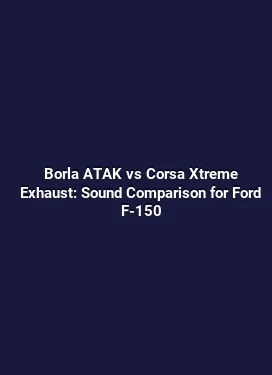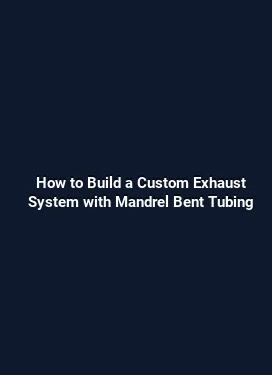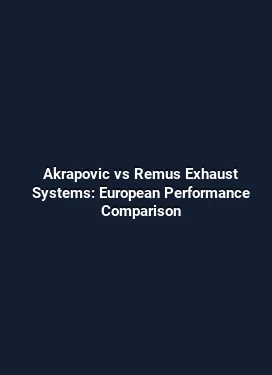Valvetronic Exhaust System Installation Guide with Remote Control
The transition to a valvetronic exhaust system with remote control combines precise exhaust flow management with customizable sound profiles. This guide provides a thorough, step-by-step approach to selecting the right components, preparing the vehicle, and performing a reliable installation. Emphasis is placed on safe handling, proper sealing, and long-term reliability, ensuring the system functions as intended across different driving conditions.
Understanding the Valvetronic Concept and System Components

Valvetronic exhaust systems integrate a valve assembly in the exhaust path that modulates backpressure. This modulation directly influences the tone and flow characteristics, enabling you to switch between a quiet, cabin-friendly mode and a louder, performance-focused profile. A remote control adds convenience, allowing on-the-fly changes without reaching for a dash switch or reprogramming the ECU under typical driving scenarios.
Key components for a typical setup include a valve body or insert, a control module, wiring harness, a remote control unit, actuators (linear or cable-driven), seals, gaskets, mounting hardware, and compatible clamps. The chosen configuration should align with the vehicle’s exhaust routing, electronic limitations, and the intended sound and performance targets. Before purchasing, verify fitment notes such as pipe diameter compatibility, length, and clearance around heat-shielding and underbody components.
Valve Valve Body Design and Placement Considerations

Valve placement profoundly affects both performance and maintenance access. Common locations are in the mid-pipe region or near the rear sections of the exhaust toward the muffler. A balance is needed between achieving effective backpressure modulation and preserving ground clearance. When evaluating designs, consider the valve’s diameter relative to the piping, the potential for exhaust flow restriction at high RPM, and the ease of cleaning and inspection for carbon buildup around the valve seat.
For remote-control enablement, ensure the actuator mount is shielded from direct heat exposure and road debris. A robust housing and shielded wiring help maintain signal integrity and reduce wear caused by vibration. The control module should be placed away from heat-intensive zones yet accessible for troubleshooting. Documenting wire routing and connector types is essential for future maintenance or upgrades.
Preparation and Vehicle Assessment
Successful installation begins with a detailed assessment of the vehicle’s exhaust system, mounting points, and clearance envelopes. Start by inspecting the stock exhaust, noting catalytic converter locations, heat shields, mounting points, and any auxiliary components such as sensors or steering linkages that may influence routing. Measuring the available space in the underbody area informs the feasible positions for the new valve assembly and remote hardware.
Drivetrain and exhaust routing interact with the overall weight distribution and chassis stress. A well-planned installation accounts for added weight, ensuring that hangers and mounts remain within tolerance and do not introduce unwanted vibrations. If the vehicle uses a factory electronic control system for exhaust tone or valve behavior, determine whether aftermarket control requires bypassing, reprogramming, or integration with existing ECU signals. While a remote control adds convenience, it should not bypass critical safety or emissions-related controls unless explicitly permitted by regulations and the manufacturer’s guidelines.
Tools, Workspace, and Safety Protocols
Set up a clean, well-lit workspace with secure jacks or a lift, wheel chocks, and a stable, flat surface. Gather standard mechanical tools: torque wrench, hex and socket sets, pliers, screwdrivers, wire crimpers, and electrical tape. A digital multimeter is valuable for verifying continuity and correct grounding of the control module and actuators. Safety gear should include gloves, eye protection, and heat-resistant clothing for working near hot exhaust components. Cooling down the system before disassembly minimizes the risk of burns and gas exposure.
During disassembly, label fasteners and retainers to ensure exact reassembly. Take photos from multiple angles to document stock routing and clearance, which becomes a reference for the new installation. If the vehicle is still under warranty, consider the impact of aftermarket modifications and consult the manufacturer’s guidelines to avoid voiding coverage in critical areas such as emissions control or powertrain integrity.
Installation Steps: From Preparation to Functional System
The installation process combines mechanical fitment with electrical integration. Following a systematic approach helps ensure a reliable, repeatable result and reduces the likelihood of rattles or leaks after the first drive cycle. Start with mount points, then progress to the valve assembly, and finally connect the remote control system to power and signaling lines.
Begin by loosening and removing sections of the stock exhaust where the new valve system will be installed. Prioritize sections that are corrosion-prone or subjected to high heat. After removing the necessary segments, perform a dry fit to confirm alignment and clearance for the valve, actuators, and remote control harness. The valve body should be installed in a position that minimizes exhaust piping bends while avoiding interference with heat shields and underbody components.
Mechanical Fitment and Sealing
Install the valve assembly using the supplied gaskets and clamps, ensuring a uniform gasket surface without misalignment. Hand-tighten clamps first to seat the gasket, then tighten to the recommended torque using a torque wrench. A light coat of anti-seize compound on threaded connections can facilitate future removal but should be used sparingly to avoid contaminating gaskets.
Check joint orientations to prevent misalignment that could cause premature wear or exhaust leaks. After part assembly, perform a visual inspection to confirm there are no gaps or misfitting components at pipe transitions. A soapy water test around the joints can reveal air leaks when the system is pressurized or gently torqued during a breath test cycle in a service mode.
Electrical and Remote Control Integration
Route the wiring harness away from hot surfaces and sharp edges. Use split loom or conduit to protect lines and keep harnesses organized with zip ties and labeled channels. Connect the actuator power and signal lines according to the manufacturer’s diagram, ensuring correct polarity where applicable. Ground connections should be solid and free of corrosion; poor grounding can lead to erratic valve behavior or remote control dropouts.
Program the remote control to match the desired valve positions for each mode. Many systems provide a lag-free response when the actuator is powered and the valve is commanded to open or close. Validate the remote range in a safe, controlled environment, then test transitions at low engine load before subjecting the setup to high-RPM operation.
Sound Tuning, Performance, and Practical Considerations
A primary aim of a valvetronic setup is to offer a spectrum of exhaust tones without sacrificing exhaust flow. The valve position directly influences backpressure, which in turn affects engine torque curves and throttle response. In practice, configuring the valve to remain closed at idle and low RPM often yields a refined, quiet cabin experience, while opening the valve at higher RPM unlocks a deeper, sportier exhaust note and potentially marginal gains in perceived throttle response.
Beyond tone, consider the impact on exhaust gas temperatures and flow dynamics. A valve that remains partially open under certain loads can help reduce backpressure without creating excessive turbulence. This balancing act is particularly important in naturally aspirated versus forced-induction engines, where the tuning objective may differ among high-revving naturally aspirated builds and turbocharged setups. Experiment with transitional points where the remote control shifts between modes, ensuring smooth, monotonic changes rather than abrupt, disruptive puffs of sound.
Operational Scenarios and Real-World Use
In daily driving, a listener-friendly mode at city speeds can minimize cabin noise and drone. On a weekend road test, flipping to a louder, more aggressive tone can enhance the sense of performance without requiring a full engine remapping. For track-day enthusiasts, some installations offer a dedicated track mode that prioritizes power delivery and a consistent exhaust response, with safeguards to prevent noise violations or overheating during prolonged sessions.
Remote control reliability depends on factors such as transmitter battery life, interference from other devices, and the quality of connectors. Regularly inspect the remote and receiver for signs of wear or corrosion, and keep the transmitter away from moisture and extreme temperatures. A dedicated storage cradle or protective pouch helps preserve battery life when not in use.
Maintenance, Diagnostics, and Troubleshooting
Like any aftermarket performance component, periodic maintenance ensures longevity and consistent behavior. Start with a routine visual inspection at every service interval: verify clamps are tight, gaskets remain intact, and there are no signs of exhaust gas leaks around valve joints. Carbon buildup can affect valve operation, particularly if the valve sits in a high-flow region with frequent opens and closes. If you notice degraded valve response or unusual sounds, inspect the actuator linkage for play and confirm that the actuator’s mechanical connections remain secure.
Diagnostics benefit from a methodical approach: confirm power and ground integrity, test actuator travel with the remote, and verify that the valve returns to a known default position when power is removed. If a control module warning occurs, consult the wiring diagram and confirm that signal lines are not shorted or open. Cleaning connections with dielectric grease can improve continuity in oxidizing environments, but avoid applying excessive lubricant on moving surfaces that could attract dust or foreign particles.
Common Issues and Fixes
Excessive exhaust heat near the valve housing can accelerate wear of seals and couplings. If heat-related damage is suspected, consider additional heat shielding or relocating components to maintain an optimal thermal envelope. If the remote control fails to engage the valve, recheck battery levels, reset the control unit, and ensure that there are no conflicting signals from other remotes in the vicinity. For leaks, re-seating the gaskets and re-tightening clamps often resolves most problems; in persistent cases, replace worn gaskets to restore proper sealing.
Safety, Compliance, and Long-Term Reliability
Safety remains a priority throughout the installation process. Work only with the vehicle stationary, supported securely, and with the engine off and cool. When integrating emissions-related components, verify that the installation complies with regional regulations and that the modifications do not adversely affect catalytic efficiency or sensor readings. Choose hardware and fasteners rated for automotive use, and avoid alterations that could compromise structural integrity or ground clearance. The goal is to achieve a secure, weather-resistant installation that endures road conditions and seasonal changes without frequent adjustments.
Long-term reliability hinges on thoughtful maintenance, proper mounting, and clean electrical connections. Periodic inspections should focus on corrosion resistance, tension on clamps, and the integrity of the remote control system. A well-executed installation balances performance, sound, and durability while preserving the vehicle’s overall driveability and daily usability. As with any performance-oriented modification, a measured, informed approach yields the most consistent results across varied driving environments.
Compatibility, Fitment, and Optional Upgrades
Before committing to a specific Valvetronic exhaust arrangement, confirm compatibility with the vehicle’s exhaust diameter, mounting points, and heat-shield layout. Some systems offer multiple valve sizes to accommodate different pipe diameters and backpressure characteristics. If planning upgrades such as a larger diameter rear muffler or additional resonators, verify the valve’s ability to accommodate altered flow paths without introducing excessive backpressure or turbulence that could undermine response times.
For those seeking enhanced convenience, consider integrating a smarter control interface that can memorize driving profiles or adapt to ambient noise levels. While keeping within the manufacturer’s recommendations, these upgrades can unlock more granular control over the valve’s behavior and enhance user experience in diverse scenarios, from daily commuting to performance driving sessions.
Mounting Styles and Aesthetics
Beyond functional considerations, the visual finish of the valve and associated hardware contributes to the overall aesthetic of the undercarriage. Choose corrosion-resistant finishes, such as stainless steel or coated assemblies, that better withstand road salt and moisture. A clean, OEM-like installation can preserve the vehicle’s resale value while delivering the enhanced acoustic experience that enthusiasts seek.
When routing electrical harnesses, run cables away from heat sources, moving components, and sharp edges. Secure harnesses with properly sized ties and ensure that slack is managed to prevent wear during suspension travel or heavy vibration. A tidy installation minimizes the probability of future troubleshooting and demonstrates a professional approach to modifications.
Final Notes on Real-World Use and Enjoyment
With a well-planned install and careful tuning, a valvetronic exhaust system with remote control can offer a broad tonal range, improved throttle feel, and the satisfaction of personalized sound management. The interplay between mechanical design, acoustic characteristics, and user-driven control creates an adaptable solution that can suit a variety of driving moods. Embrace a patient, iterative approach: test transitions, note the response, and refine the control settings to match preferred driving conditions without compromising reliability or safety.
As with any performance modification, documentation of all changes is prudent. Maintain records of parts, torque specifications, and wiring diagrams to facilitate future maintenance or part replacements. Sharing practical experiences with a community of enthusiasts can also yield valuable insights into optimization strategies for different vehicle configurations.






